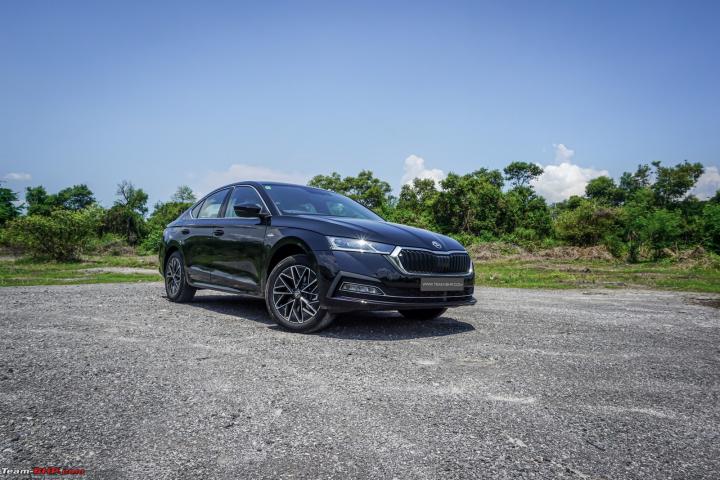News
Analysis: The downfall & extinction of D-segment sedans in India
From April 2023, due to the BS6-RDE emission compliance phase in India and reluctance on the part of Skoda to upgrade drivetrains, became the final nail in the coffin of the Octavia and Superb.
BHPian pqr recently shared this with other enthusiasts.
Graveyard of premium sedans

From April 2023, due to the BS6-RDE emission compliance phase in India and reluctance on the part of Skoda to upgrade drivetrains, became the final nail in the coffin of the Octavia and Superb. As production of non-compliant BS6-RDE passenger vehicles was not allowed after March 31, 2023. However, sales of BS6-compliant vehicles produced before April 1, 2023, are still allowed.
With that, an era of premium sedans also came to a grinding halt as the Camry hybrid remained the lone player on ventilator support from Toyota.

Overall, the 2023 sedan landscape does not look promising either. Sad news for many remaining sedan lovers, but this story had a quite an upbeat start in 2001.
Premium sedan segment
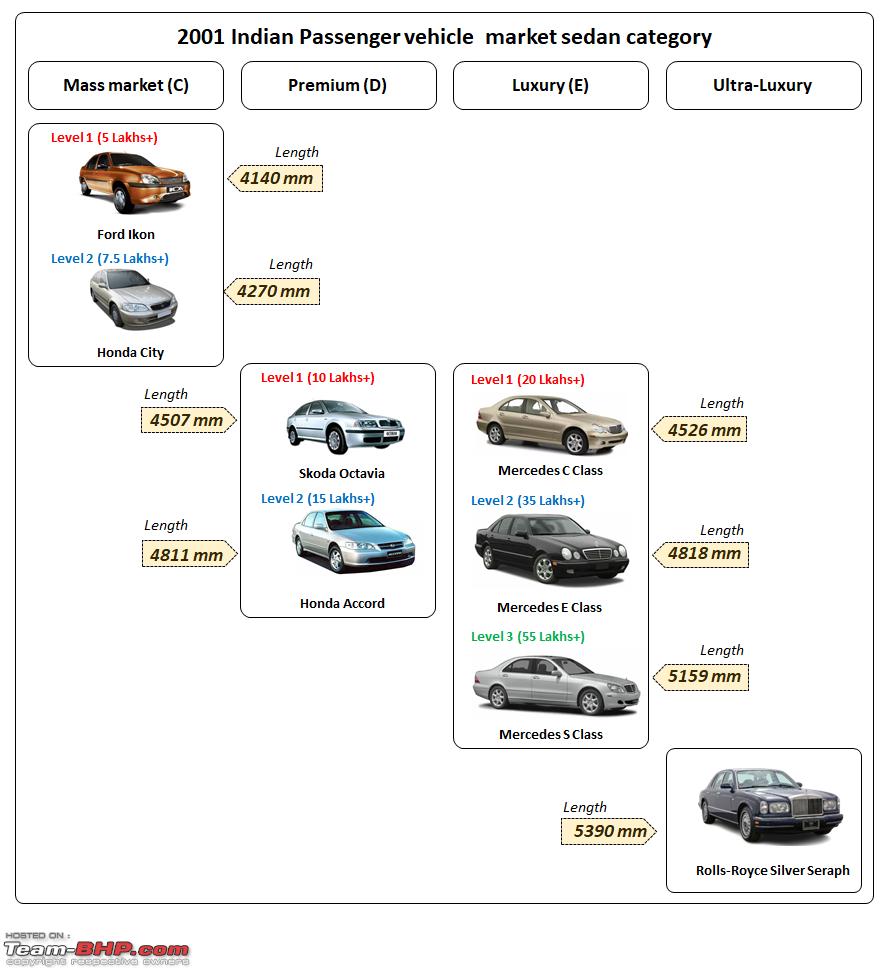
So, what exactly is India's premium sedan segment?
For that, let’s revisit the starting point. India's economic liberalisation began in the early 1990s. By the mid-90s, many foreign carmakers started investing in India and brought new sedan products from their global portfolios.
These products were contemporary with new-age technology in comparison to the archaic Hindustan Motors Ambassador and Premier Padmini, which remained staple sedan products for decades due to the government’s policies.
Then came the new hierarchy of sedans. There were mass-market sedans (C1) with a low entry price point like the Ford Ikon, Maruti Esteem, Fiat Sienna, etc. Then there were a few more powerful and larger categories of sedans, like the Honda City, Mitsubishi Lancer, and Opel Astra, etc often called mid-size sedans (C2).
In 2001, Skoda launched the Octavia in India. It was larger than the Honda City, with a much larger engine and thus more power, and an upmarket interior with more new age features, as well as some top end features of the lower segment (C2) being standard from the start. Thus being more premium in every aspect, thus earning the ‘premium’ tag or ‘affordable luxury’, also referred as D1 sedan segment in India.
In the same year, Honda and Hyundai launched the Accord and Sonata, respectively, which were a size bigger from the Octavia and thus entered the second and higher level of the premium sedan category with even even more in-cabin space, also referred as D2 sedan segment in India.
In luxury parlance, there were the Mercedes-Benz C-Class and E-Class, respectively, of similar size with better cabin experience and driving performance, thus commanding a much higher price.
Cars have always been a status symbol in India, and in the era of the sedan, the longer the sedan, the higher the prestige value. This made this particular hierarchy from 2001 a little more rigid.
Important to note here is that products in the premium and luxury segments are global in nature, with little customization for small local markets. They arrive in India via either the CKD (completely-knocked-down) or CBU (completely-built-unit) import route, attracting differential custom duty and remaining vulnerable to foreign exchange development.
Rise and fall of premium sedan segment

With different brands bringing in new products, the premium sedan segment grew rapidly until 2007. By that time it had reached its peak of 18% share in overall sedan market. The global recession and slowdown in growth of the Indian economy resulted in subdued consumption in 2008 and 2009. Following that, 2010 sales nearly reached its previous peak.
And that’s where the story of the decade-old rapid growth of the premium sedan segment ends. All of a sudden, since 2011, demand for premium sedans has started to fall. So what started shifting the demand away from the premium sedan segment?
Tremors – fuel price differential and adverse forex development

Following 2010, there was a shift in demand for diesel-powered vehicles, as the petrol-diesel price differential reached an all-time high during the double dip global recession. Premium sedans without diesel engines have come under fire, as the fuel consumption of large petrol engines is higher, resulting in a higher running cost. As a result, diesel sales in the premium sedan segment reached 74% in 2012. Prompting brands like Honda to discontinue both its Civic and Accord models as they had a petrol-only drivetrain option. Products with a diesel heart option survived the storm, but by then another storm was waiting.
The forex rate surged in the meantime, forcing brands to raise prices as almost all of them were having CKD operations with large imported contents. This forced them to raise the price without a commensurate increase in value. Demand began to fall further as a result of price elasticity. As several buyers either switched to a higher trim of sedan from a segment below (C2), as latter also grew in size, with more equipment than before. For example Honda City by then got a sunroof for V CVT variant at ₹ 10.2 lakh ex-showroom price. In higher price band, customers were lured away by heavily discounted entry-level luxury products from German trio.
Were the premium sedan segment market ready for another disruption?
Tectonic shift - SUVfication and a change of heart in Indian customers

This is the time period when SUVs like Mahindra XUV 500 and Toyota Fortuner were also launched in their respective segments, each with a local production base, and each started openly attracting demand for SUVs.
This ensued a new decade, when Indian customers quickly switched to a new favorite body style (SUV) that provides similar in-cabin space with the added functionality of ground clearance. The emotional benefit of an imposing image from the outside and a commanding position from inside, the SUV took precedence over the driving dynamics offered by sedans, and it also helped to overcome the inconvenience of body roll in the tall SUV.
One of the former Director of sales and marketing at Maruti-Suzuki (Mr. R.S. Kalsi) has beautifully summarised this emotional benefit as "Unchi is the new lambi", loosely translated as taller and more imposing SUVs are now the new parlance of longer sedans in terms of desirability and prestige value.
Premium brand : winners and losers
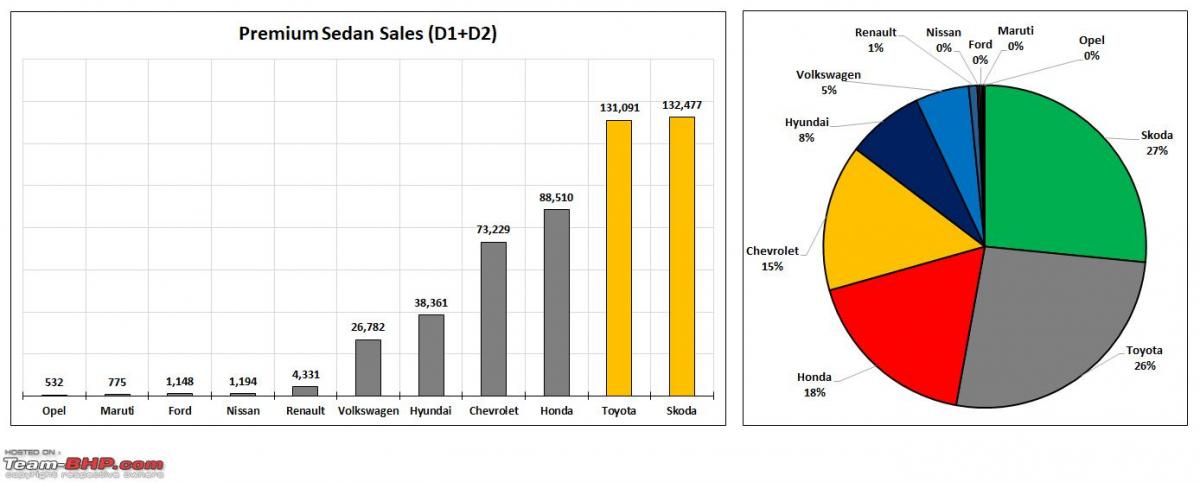
Because these automakers also sold mass-market products, the premium sedan segment became a proving ground for brand identity in India. As premium positioning in the minds of customers can be leveraged for better pricing opportunities. Skoda and Toyota have been the most successful players in the premium sedan segment, followed by Honda and the Chevrolet brand. Despite the success of their premium sedan products around the world, Hyundai and Volkswagen have always played second fiddle in India.

Volkswagen, in fact, worked hard in India to achieve European positioning, where it is one step ahead of Skoda, and charge premium pricing over sister brands – Skoda and Seat. However, that never materialized in India. This is because Skoda has been the definitive brand in India when it comes to premium sedans, and it has also remained an important part of the premium sedan growth story. Skoda’s most affordable product, the Fabia (hatchback), with its initial CKD origin, never diluted its positioning in the mass market segment until the rebadged Volkswagen Vento landed in Skoda’s India stable under the name of Rapid.
Nissan, Renault, and Maruti just ended up with a wannabe image in the premium sedan segment. Ford failed in the premium sedan segment, however, found success with the Endeavour SUV. Opel's story was very short lived, as GM has replaced it with the Chevrolet brand in India.
Premium sedan D1 products : winners and losers

Toyota led the way in premium sedan D1 segment, followed by Skoda, Chevrolet, and Honda. Toyota Corolla, Honda Civic, and Skoda Octavia took the crown on occasion, and Hyundai Elantra once by chance.
Skoda Octavia (2001-2006-2014-2021-2023)
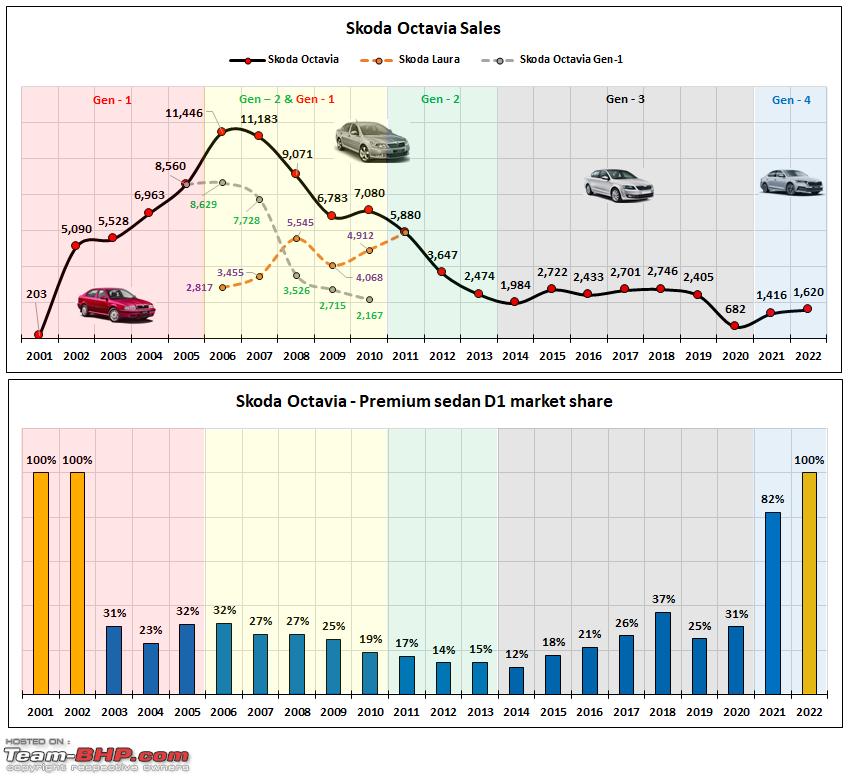
Spanning over four generations and more than two decades of presence, Octavia marks the start and the end of the Premium Sedan D1 segment. Octavia developed a cult following among Indian customers and was regarded as the creamy layer in the premium sedan D1 segment. Octavia has always been known in India for premium interiors, a battle tank-like build, huge interior space, a long equipment list, and a great driver’s car. In its early years, the Octavia offered alloy wheels, which even the Mercedes-Benz C-Class did not have. The L&K variant launched later in 2004 was equipped with more equipment, including a sunroof, a bi-xenon projector headlamp, and leather upholstery. Octavia also demonstrated early on that a diesel engine could be refined and enjoyable. Octavia also introduced Volkswagen AG’s turbo-petrol (TSI) and dual-clutch transmission (DSG) technologies to this segment.
The first generation Of Octavia was quite successful in India, as Skoda continued to introduce new variants. In 2005, Skoda took the decision to bring the second generation of Octavia to India and named it Laura. Renaming was done because Skoda India continued to sell older generations simultaneously, by repositioning. Laura's sales grew slowly, and success wasn't the same as that of the first generation Octavia.
The third generation Octavia was built on Volkswagen's new MQB platform, and its design was inspired from Audi. There was also a steep price hike. Third generation’s sales reached its highest level when the quad-headlamp facelift was launched. Octavia's fourth and last generation came without a sunroof, and its overpriced perception limited its sales number.
Skoda has also introduced a high-performance version of the Octavia known as the vRS. The first vRS was launched in 2004 with a 1.8L TSI petrol engine and 150 PS power output, at ₹ 13.2 lakh. Later in 2018, the vRS version was re-introduced with a 2L TSI petrol engine having 230 PS of power output, as the 1.8 TSI became the staple engine for the regular Octavia. At ₹ 24.6 lakh, the price was appealing. This was followed by the final iteration of vRS with 245 PS power output and front LSD, came in 2020 as a CBU import with a hefty price tag of ₹ 35.99 lakh. Both 2L TSI vRS versions were sold in limited numbers.
Skoda also experimented with a station wagon version of the Octavia in 2005, which wasn’t successful as Skoda was able to sell only 229 units until 2008. Indians rejected the concept of station wagon from the start, introduced by other brands as well from time to time.
Toyota Corolla (2003-2008-2014-2020)

The Corolla remained the best-selling car and maintained its leadership position in the premium sedan D1 segment. It also remained the only car in the segment without a sunroof throughout its three generations. The Corolla has a decent and spacious interior, and a satisfactory feature list. The Corolla was mostly regarded for its typical Toyota qualities of reliability and low maintenance cost. In its third generation, the Corolla skipped conventional design language and adorned little flamboyant looks inspired from Lexus.
The Corolla came with a refined and reliable 1.8L VVT-i engine from beginning to end. In 2010, it was joined by a 1.4L diesel engine with a mere 90 PS power output, quite underwhelming from a competition stand point, but engine was high on fuel efficiency at 21.4 kmpl ARAI certified figure. In 2012, the diesel mix for the Corolla reached an all-time high of 66%, as low power figures did not deter chauffeured customers.
Chevrolet Optra (2003-2012)
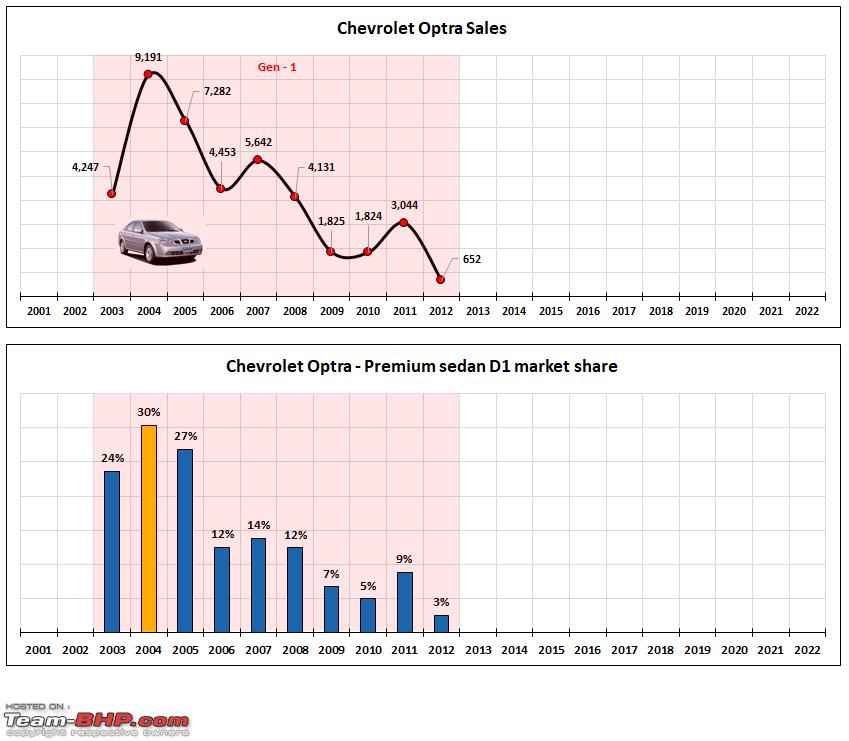
Chevrolet introduced Daewoo Lacetti as a rebadged Optra in the Indian market and positioned it at the lower end of the price spectrum. Though a size smaller in the competition basket, it always remained a value for money offering in the segment. It was introduced with a 1.6L and 1.8L naturally aspirated petrol engine. Later, it was followed by a 2L diesel engine in 2007, in a facelifted avatar with the Magnum suffix.
Hyundai Elantra (2004-2008 & 2012-2016-2021)

Elantra always came with all the bells and whistles, including a powerful CRDi diesel engine, but it never felt too special or desirable in the competition basket.
Second generation Elantra having fluidic design theme immediately caught the attention of buyers, in 2012. In India, the first three years of the second generation Elantra were the best.
The third generation Elantra featured a Jaguar-inspired design, but sales were disappointing. After a radical facelift in 2019, sales were grounded, forcing Hyundai to pull the plug. The Elantra story has a subtle hint about how overall brand image matters in an Indian context.
Honda Civic (2006-2012 & 2019-2021)

With ingredients like - sports car like silhouette, a twin pod tail lamp inspired from Ferrari, a futuristic aircraft like cockpit, and a spirited 1.8L naturally aspirated petrol engine, the Civic became an instant hit among young buyers. Thus, Civic also achieved its highest ever sales mark of 17,329 units in 2007, which is also the best in the segment. Civic often used to scrapes its belly on Indian roads, due to the low ground clearance, and limited boot space it offers, were major purchase deterrents. The lack of diesel engine and high petrol prices after 2008 made Civics’ life more difficult, forcing Honda to pull the plug in 2012.
In 2019, Honda relaunched the Civic with a similar petrol and new diesel drivetrain. After only three months on the market, Civic's sales have slowed due to mismatched value proposition of drivetrains on offer. Diesel was underpowered, that too without automatic transmission option, and petrol was paired with CVT transmission only, which robbed the driving performance. Rear seat was too low positioned for the Indian market, and the sloping roof line reduced rear headroom, so back seat prospects simply ditched the idea of buying a Civic.
A CKD assembly line was located at Honda’s Greater Noida facility, and while shifting operations to new plant located at Tapukara in Rajasthan, Honda didn’t had a business case to set up a CKD assembly line, because Civic and CRV weren’t selling well due to Honda’s own fault. Finally Civic was discontinued in 2021.
Volkswagen Jetta (2008-2011-2017)

In India, Volkswagen also took a top-down approach, launching premium products to build brand image before going mainstream. The 2008 Jetta was made in India from CKD kits imported from Mexico. There were two engine options, a 1.6L naturally aspirated petrol engine and a 1.9L TDI diesel engine. The design was conservative by Indian standards and didn’t work well in Jetta’s favour.
The second generation Jetta was launched with a 2L TDI diesel engine followed by a 1.4L TSI petrol engine, both in a lower state of power tune with a steep price change. This generation was underpinned by the old PQ35 platform, whereas cousin - Skoda Octavia moved to the MQB platform in 2013. Despite its built-like-a-tank appearance, the conservative German styling, steep price, close front-face resemblance to the Vento, and engines in lower power tuning kept its appeal limited in the competitor basket.
Chevrolet Cruze (2009-2017)

Cruze was launched in India with a 2L diesel engine having 150 PS of power output. The design was sporty and contemporary with a decent feature level, all this has propelled its sales into the fast lane in a market with strong demand for diesel powered vehicles during those times. Positioned above Chevrolet Optra, it retained the #2 spot in the D1 premium sedan segment for three successive years. Being developed for the American market it surely lacked finesse of European counterpart, though.
Continue reading BHPian pqr's thread on the demise of D-segment sedans for more insights and information.



